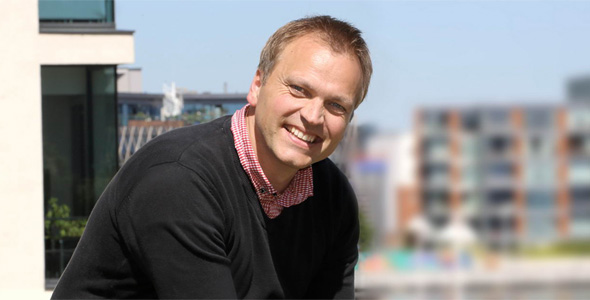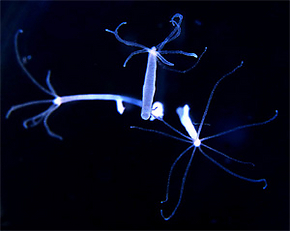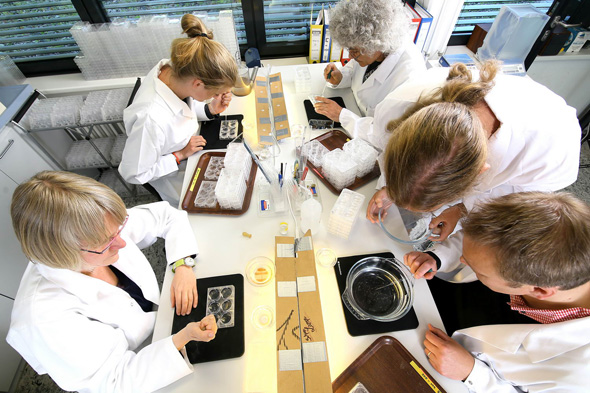October 17, 2015 | News | Max Planck Research
A Hint of Immortality

What’s the secret of longevity? Ralf Schaible is also looking for the answer to this question in the polyp’s genes. © MPG
Eternal life lasts a very long time. Nevertheless, Ralf Schaible from the Max Planck Institute for Demographic Research in Rostock can already affirm that the freshwater polyp Hydra comes quite close to this ideal. In a long-term experiment initiated by the institute’s Director James W. Vaupel, he and his colleagues investigate why, under certain circumstances, Hydra doesn’t age.
TEXT: KLAUS WILHELM

Delicate beauty: Hydra, which grows to a size of just one centimeter, is tougher than its frail-looking body suggests. In the lab, this freshwater polyp can theoretically reach an age of several hundred years. © MPG/ Bernd Hagedorn
The freshwater polyps at the Max Planck Institute in Rostock get absolutely everything they need for a long life. After all, “the experiment,” as Ralf Schaible calls it, has no use for unhappy animals. That’s why Schaible creates paradisiacal conditions for these tiny animals, which measure less than one centimeter in length and are as thin as a needle: “We pamper them with everything they could ever dream of.” Several of his staff are tasked with feeding the nearly 1,800 polyps. Using extremely fine pipettes, they deposit the polyps’ favorite food directly onto their tentacles: brine shrimps, small crustaceans. They get the same ration every time, delivered free of charge, three times a week – and that for nearly ten years now.
The Hydra seems to enjoy it. Under these conditions, the species has now revealed its secret: “Hydra doesn’t age,” says Schaible, summing up the experiment’s spectacular findings, “it’s had a constant mortality rate throughout all these years.” Previously that seemed, from a scientific perspective, impossible.
The body breaks down with age
Aging, mortality, immortality – these topics have held a fascination for humans since well before the post-postpost-modern era. And for good reason: dark circles plow ever deeper furrows under our eyes. Our skin and connective tissues sag. Wrinkles cover our necks and faces. Reading glasses sit on our noses like a senior citizen ID card. Our minds aren’t as quick as they once were. The sprint to the next bus stop becomes more like a tired trot.
No, aging is no fun, and with every passing day, the risk of dying increases. Some of us find the process frightening. Others confidently proclaim that they don’t care – even though perhaps they, too, stand in front of the mirror each morning and furtively but meticulously examine their wrinkles. And who knows: maybe they also secretly hope that science will one day be able to halt this course of events, like the medieval alchemists who sought the elixir of eternal life. In Ralf Schaible’s view, however, that was – and is – a vain hope: “I think immortality is impossible,” he says, “even in an organism like Hydra.”
Hydra possesses truly astonishing properties – just like the eponymous character in Greek mythology, the many-headed monster that grew two new heads for each one it lost. And the head in the middle of its body is immortal, besides.
Like its mythological role model, the freshwater polyp, too, replaces the body parts it loses. “But why can they do that and others can’t?” Schaible wonders. Does it have to do with Hydra’s extreme longevity?
The longer the experiment continues, the more convinced the researcher becomes that it does. With an expected end date on December 31, 2017, the experiment began on March 1, 2006. That’s when the scientists began to spoil Hydra 1 from cohort number 1, as well as all the offspring it produced.

Daily feeding routine: The researchers have to provide food to nearly 1,800 polyps every day. They use fine pipettes to dispense small crustaceans into the dishes. © MPG / Bernd Hagedorn
Each animal lives in its own dish of water with minerals at a constant temperature of 18 degrees Celsius. They always receive the same amount of food and follow the rhythm of a normal day with light and darkness. To round out this life of luxury, they live in their petri dishes without fish or other animals that might eat them.
Right after the start of the experiment, Hydra 1 began to reproduce asexually. The researchers collected the offspring and gave each of them a “private room” as well – more than 1,800 times to date.
Nevertheless, there are some deaths. Most of them are due to lab accidents, for instance when individuals stick to the covers of their dishes and dry out, or fall on the floor. But the occasional Hydra also dies a natural death: it first stops eating and shortens its tentacles; next, the entire body begins to shrink; after one to two weeks, the animal dissolves into its component parts. “But so far,” says Schaible, “we have rarely observed this kind of death.”
The scientists also determine the asexual reproduction rate. For this, they count every new daughter organism. “To date, more than 30,000 genetically identical polyps have been created in this way,” says Schaible. He has detailed data from more than 1,800 individuals. The most productive animal has produced 341 offspring so far, others just 10 or 20.
The researchers’ aim for their long-term experiment is to determine the animals’ natural mortality over many years. From the number of annual deaths, they calculate the probability of death for each age. Demographers have always been interested in this factor. In humans, the probability of death changes continually, usually increasing. The change in the probability of death is what demographers call aging.
It is in this context that the scientists working with James Vaupel in the Laboratory of Evolutionary Biodemography have, for some time now, also been analyzing the probabilities of death in animals. For biologists like Schaible, this is an “entirely different world, and one that I first had to learn to understand,” says the Rostock-based researcher. Natural scientists normally tend to look at aging from a physiological standpoint, and at the level of cells and molecules: muscle strength andmetabolic rates decrease over the span of a life, the genetic make-up changes, and so on.
Schaible realized, however, that the Hydra experiment offered the chance to show that organisms age and die in very different ways. The team in Rostock has thus been keeping meticulous records for nine years now about when the polyps are born and when they die. Now they know that “Hydra has a constant mortality risk, and it doesn’t age because its mortality doesn’t change with increasing lifespan.”
In other words, regardless of whether an individual is just one year old or nine, its risk of dying remains the same.
Hardly any fatalities per year
Moreover, the mortality is surprisingly low, especially for such a small animal. Per year, only one in around 220 individuals dies. All the others continue on and on and on. The polyp thus has a life expectancy of several centuries (see page 26) – so it’s not immortal, but almost. “One might think that for such a small, fragile organism, even ten years must be an eternity,” says Schaible.
“The scientific community initially ridiculed our findings,” concedes the scientist. The experiment was said to be simplistic. But the criticism gradually abated – the data was simply too conclusive. It supported the hypothesis that aging processes are extremely variable and are influenced by genes and by environmental conditions.
So living organisms age differently – a finding that contradicts the popular theory that, upon reaching sexual maturity, mortality increases while fertility decreases. The data on the probability of death and the reproduction of 46 species that James Vaupel and his colleagues at the Max Planck Institute in Rostock and the Max-Planck Odense Center on the Biodemography of Aging in Odense, Denmark, calculated (see page 26) shows the diversity of aging patterns in nature.
In primates, baboons and chimpanzees, the probability of death follows the standard curve and resembles that of humans. In other species – such as the violescent sea-whip coral, the oak or the Californian desert tortoise – the mortality risk decreases continually even well into old age – probably because they grow ever larger and can thus withstand predators ever more successfully. In many birds, the risk of death initially increases and then remains constant. The constant and extremely low mortality of Hydra, however, is unique in the animal kingdom.
“But the aging processes also vary within a species or group of animals,” explains Schaible. Japanese biologists, for instance, studied the species Hydra oligactis. At a water temperature of 18 degrees, the animals diligently produce buds and don’t age. At 14 degrees, in contrast, the species begins to reproduce sexually. This means that the animals now produce only eggs and sperm, and die after five months. In this case, the probability of death increases with time – just as in humans. In other Hydra species, however, in the same experiment, mortality doesn’t increase. So sexual reproduction doesn’t reduce life expectancy in Hydra in general.
The researchers therefore don’t yet know whether the difference in mortality is merely an adaptation to lower temperatures or a true aging effect. Apparently, however, the old notion that mutations and other damage accumulate in an organism’s cells over the years and inevitably lead to its death is incorrect.
Thanks to its immense regenerative capacity, and under the luxurious conditions in the lab, Hydra is able to escape this decline. If a freshwater polyp is cut into two halves, in two to three days, two complete new individuals will grow. Even if the animal is cut into five pieces and only 500 cells remain, it can still regenerate quickly and precisely.
Self-renewal preserves youth
It owes this ability to renew itself to stem cells, which Hydra has more of than specialized somatic cells. These stem cells divide throughout their lives and produce all cell types needed to form or regenerate a body or individual body parts. Its body is thus constantly renewing itself, allowing Hydra, despite continuous reproduction, to grow ever older without decaying.
Through budding, Hydra continuously produces genetically identical offspring. Many genetically identical individuals reduce the probability that the genes of an individual organism will be wiped out by adverse environmental conditions. “Our Hydra apparently pays no price for its extended lifespan – its asexual reproduction is simultaneously its fountain of youth,” says Schaible.
This quasi immortality in the lab may also be merely a by-product of adaptations that help the animals survive in nature. For example, the constant production of genetically identical offspring ensures the survival of the genetic material even when mortality is high due to environmental factors. Moreover, the extraordinary ability of the polyps to regenerate increases their survival rate, for instance when predators, such as snails, nibble on them.
In parallel with the long-term experiment, the researchers in Rostock launched a few shorter studies to find out why their polyps don’t age. They subjected the polyps to minor stress, first feeding them normally, then letting them fast for 60 days, then giving them brine shrimps again. This resulted in the polyps reproducing more efficiently. They thus gained more life energy and used it more wisely, which may have further extended their lifespans.

Two weeks after Hydra was treated with UV light, the polyps changed visibly: In contrast to untreated animals (left), in some of the treated Hydra, two heads form, and the buds don’t detach (center). In others, many tentacles grow in the bud zone (right). © MPIDR/ Ralf Schaible
In another experiment, the scientists irradiated the polyps with harmful UV light or treated them with aggressive hydrogen peroxide. Both caused considerable stress for the animals, and 30 percent died immediately following exposure. Some were deformed, growing multiple heads or slit tentacles, but most of them recovered and regained their previous appearance. Now the researchers wanted to know what happens with the damage when the polyps regenerate anew.
“Hydra seems to be able to distinguish intact stem cells from damaged cells. It then responds to the damage in different ways,” explains Schaible. If few cells are damaged, they are sent to the foot and tentacles, where they specialize and, due to the short lifespan of somatic cells, eventually die. However, if too many maltreated stem cells flood the organism, the animals might choose one of two different strategies: some behave egotistically and deport the damaged cells. They collect them in the buds, from which new Hydra form. “In this way, the polyps get rid of the damaged cells and possibly live longer,” says Schaible. Others sacrifice themselves in what appears to be a selfless act: they move the few intact cells into the buds, from which healthy offspring then grow. They themselves perish.
The scientists want to conduct further experiments to determine which molecules are behind the longevity of their animals. They are focusing primarily on the protein FOXO. That’s the name of a so-called transcription factor that regulates the activity of many genes – “a sort of master switch for cell renewal and longevity,” as Schaible puts it. Using special substances, the scientists can modify the aging process of Hydra and probably also the activity of FOXO and other genes, increasing the animals’ mortality rate.
For Schaible and his colleagues, the extremely long-lived, non-aging polyp is a fascinating case of longevity. “If we were to find the genes for aging in such a non-aging organism, it would really be something special.”
This text has first been published in the issue 02/2015 of the quarterly Max Planck Research.